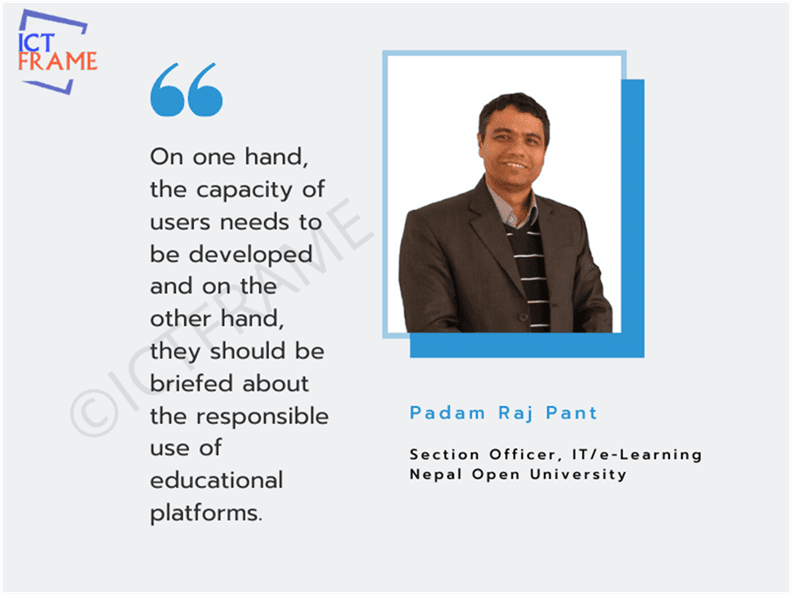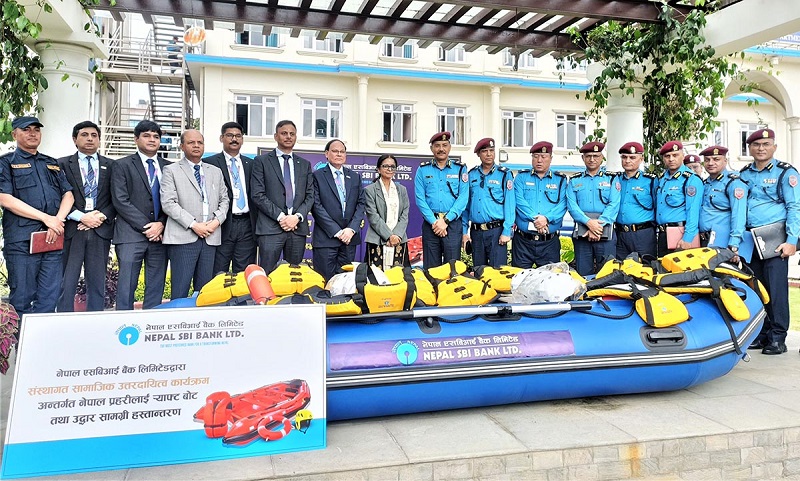The Shift Towards Online Classes | Is it Really Possible in Nepal?
27 April Kathmandu, 2020
Normal lives are still at a halt due to the nationwide lockdown in Nepal. Schools and colleges are one of the most affected thereby leaving the future of students at hold. As a result, educational institutes started adopting alternative methods of teaching and learning.
Schools, colleges, and Universities are researching for an improved online education process. PABSON, an umbrella organization for private schools had signed an agreement with Midas E-Class to provide one month free ‘digital learning’ for students of pre-primary to class 10. Since the COVID-19 outbreak, all 11 Universities in Nepal have continued their efforts to go online by preparing online content for students.
During such times, we also wonder if Nepal Open University (NOU) is doing anything different. The NOU is an open and distance learning university of the country and it must have greater experience in distance learning than others surely. But is it really the case?
Then there are several downsides to online education which makes us question if we are really doing it right. Can Nepal really make a successful shift towards online classes?
Read through to find out!
You May Also Like: How Are Colleges in Nepal Conducting Online Classes?
Interview with Deependra Bajracharya – Business Development Manager at Microsoft Operations Pte. Ltd., Singapore
Q. Do Educational Institutes in Nepal have the resources to successfully conduct online education in Nepal?
A: Honestly speaking, most schools and colleges are not prepared for online education. Microsoft has provided over 250+ educational institutes with online education resources. Some Universities like Nepal Open University and Kathmandu University (KU) are in an ideal state to conduct online education.
They already had online resources and course modules before the lockdown. However, other colleges were not even close to prepared and have just started getting ready to provide online classes.
Q. What are the educational institutes in Nepal doing right and what are they doing wrong?
A: Firstly, the realization of the fact that online education is inevitable is the most important and right thing they have done. This trend or shift is going to be the ‘new normal’ in our lives. The impact of COVID-19 is going to last for some time and we need to maintain social distance.
As per my discussion with a team in Brunei, they have started working in shifts. How this works is dividing the staff into groups of three and one group has to visit the office once in three days. The other two days, the group can work from home.
In my point of view, schools and colleges in Nepal can also adopt similar policies. If 3-4 shifts can be maintained in the educational institutes, they can record the physical classes and make the files available for other groups. For this, they can use applications like Zoom, Office 365, Midas e-learning, and others.
Talking about what they are doing wrong, I think they haven’t yet reached a complete solution. For online education, there are several other components other than live classes. For instance, does the video conferencing software that teachers are using, support recording in case of a power outage?
Similarly, they have to consider if the online learning application can support connectivity for all students, or is there a user limit. And of course, there are matters of assignments, note and content sharing, examination and result publication. For example, Microsoft OneNote can help to share notes to students by providing access to selected users. Software like Microsoft Office 365, Moodle, and E-Learning can provide a complete solution to facilitate proper online education.
So, I would say that educational institutes are failing to choose the right technology considering all these components and limitations.

Q. What are the negative aspects of online education?
A: Being a parent myself, I would say that children are enjoying the use of the internet too much. A shift to online education means providing children with devices. One major disadvantage I think is the distraction caused by the entertainment aspect of the internet.
If you leave your children unmonitored, they can be playing games or watch videos on the internet. Another biggest disadvantage would be the limitation of physical movement. So, it might have an effect on the mental and physical health balance in the long-term.
Q. How can online education be conducted safely and securely?
A: The first thing is making the users aware of the positive and negative aspects of the internet. I believe it is not as necessary for college-level students because most of them are well informed of the rights and wrongs. Meanwhile, it is extremely essential to inform the juniors regarding device safety and cybersecurity.
Another thing is that if you are a parent, you need to make sure that you have enabled parental controls. Parents must monitor the online activities of their kids to maintain online discipline. Similarly, educational institutes must choose online platforms that don’t have any security vulnerabilities.
For instance, there are many cases against Zoom including data leaks. So, people need to be aware of data privacy as well. I suggest choosing a platform that is certified or associated with a compliant company. So, the authorities have to make sure the chosen platform complies with certain standards.
Interview with Padam Raj Pant – Section Officer, IT/e-Learning at Nepal Open University
Q. Is there a possibility of providing a complete virtual class in Nepal?
A: Well, we are doing it for many years. At present, most colleges are using Zoom for video conferencing but it’s not a complete learning solution. An online educational platform must facilitate assignments, feedback, grading, reporting, and overall managing.
For instance, colleges need to manage and report the number of classes conducted in a day, the attendance of students, etc. This is how the educational process becomes systematic. Otherwise, live classes are just a form of counseling in my opinion.
Q. How has NOU’s online education been different before and after the lockdown?
A: There hasn’t been a drastic shift for NOU since we already had the distance learning facilities. When a student applies for admission in NOU, we make sure to provide orientation for classes, routines, and resources online. So, the pandemic hasn’t affected our regular workflow as much. In fact, we are also providing guest lectures to students from Professors from top abroad Universities.
Q. How does NOU accept new admissions and fee payment?
A: Let me clarify that the only times the students need to be physically present at NOU is during orientation and examination. But eventually, we have adopted online orientation, interview, and training as well. Now, we are also planning to shift examinations and assessments online soon.
Talking about fee payment, our students don’t need to visit our center physically. They can make payments through digital platforms like eSewa or ConnectIPS. Similarly, they can deposit the fees in the bank account and send us the voucher for payment confirmation.

Q. What online platforms are the NOU using to conduct online classes?
A: Firstly, we have an e-library in which students can access the contents subscribed by the University from their own devices. Similarly, we have synchronous and asynchronous morality of teaching. For synchronous, our lecturers use Microsoft Teams to conduct live classes with the students. We have been using this application since its launch in the market.
On the other hand, the lecturers can also upload their teaching recording and other resources that students can access later. This is the asynchronous method of teaching that facilitates e-learning as well. For this, we use Moodle, an open-source Learning Management System (LMS), that I am using it since 2008/09 before that I was working at KU but Nepal open university started in 2016.
Furthermore, for managing student’s data and information, we have been using EMIS (Educational Management Information System). We monitor student’s inquiry, entrance, fee structure, etc. using this system. Similarly, we provide remote support with AnyDesk in the event of problems faced by the student.
Q. Being a pioneering University of Nepal in distance learning, what are other educational institutes doing wrong at present?
A: During a crisis, we need to find solutions rather than new problems. There are several components involved in online education, not just live classes. So, educational institutes have to research what they need and how they can implement it. There are many tools, educational equipment, and resources available to start.
So, looking and what they have and what they need, they have to follow a decision. At the same time, they have to consider the capacity of both teachers and students. That is why it is extremely important to prepare a guide on what to use and how to use it.
These guides will help users to cope with whatever issues that may arise in the future. Similarly, students should be made aware of cybersecurity and threats. So, educational institutions have to go parallelly. On one hand, the capacity of users needs to be developed and on the other hand, they should be briefed about the responsible use of the software.
Also, if Universities and colleges provide proper guidelines to students, it will help to avoid any legal issues.
You May Also Like: Tribhuvan University Issued Guidelines For Teaching Through Online Classes
Q. How can educational institutes cover the nationwide participation of students?
A: Looking at the current scenario, the coverage of Nepal Telecom and Ncell has already reached most remote areas of Nepal. So, not only educational institutes but telecom industries and ISPs can also contribute to making e-learning available in remote areas.
For instance, in other countries, there is a concept of zero SIM. This basically means that people that have such service can browse the government or educational sites enlisted for free. My point is that we need to separate the data usage for educational purposes and entertainment purposes.
We are all facing a pandemic and there is no escape from it, at least not for some months. So, educational institutes or government agencies can establish a strategic partnership with the Telco industry to reduce the data usage rate of their resources online.
Final Say
Most colleges and Universities may have shifted their education process online. However, there seems to be confusion and uncertainty in selecting the correct platform. Obviously, there are other challenges of student participation as well.
Experience of companies like Microsoft and universities like NOU will speed up the process in the current crisis. Online education has certainly become inevitable. Online education in Nepal has changed to a matter of ‘how to implement’ rather than ‘when to implement’.
So, I believe educational institutes must seek guidance from IT experts and produce guidelines for their students. This is how they speed up their online education process and cover a large ground.
Related Articles
Broadway Infosys Started Online IT Courses In Nepal
Fusemachines Launches AI-Enabled Classroom | Will AI Shape the Education Sector?
KMC School Starts Online Classes from Playgroup to Grade 10
Google Education Group Starts Training Schools For Online Education In Nepal






